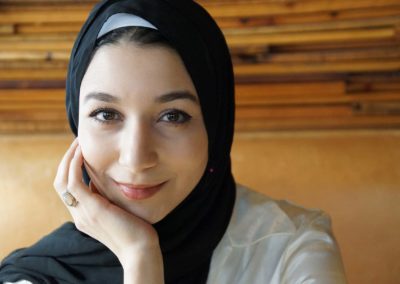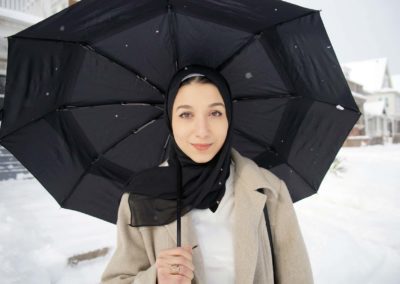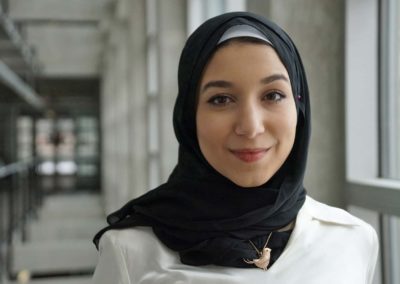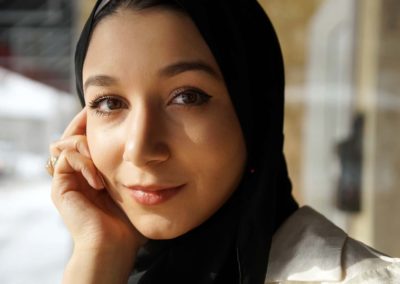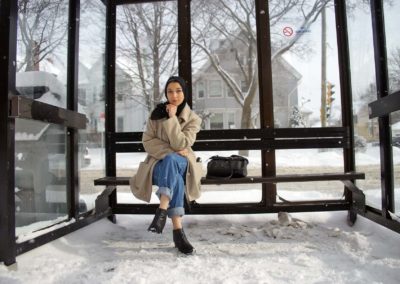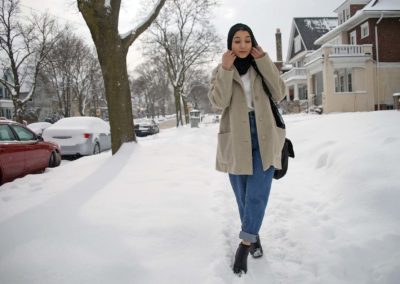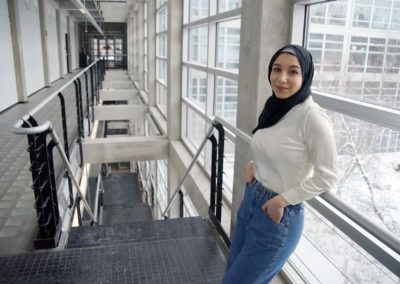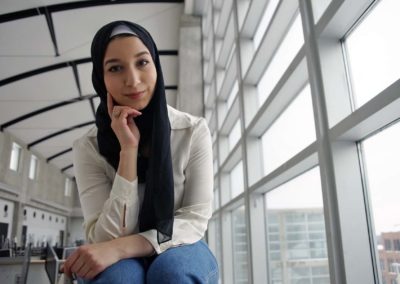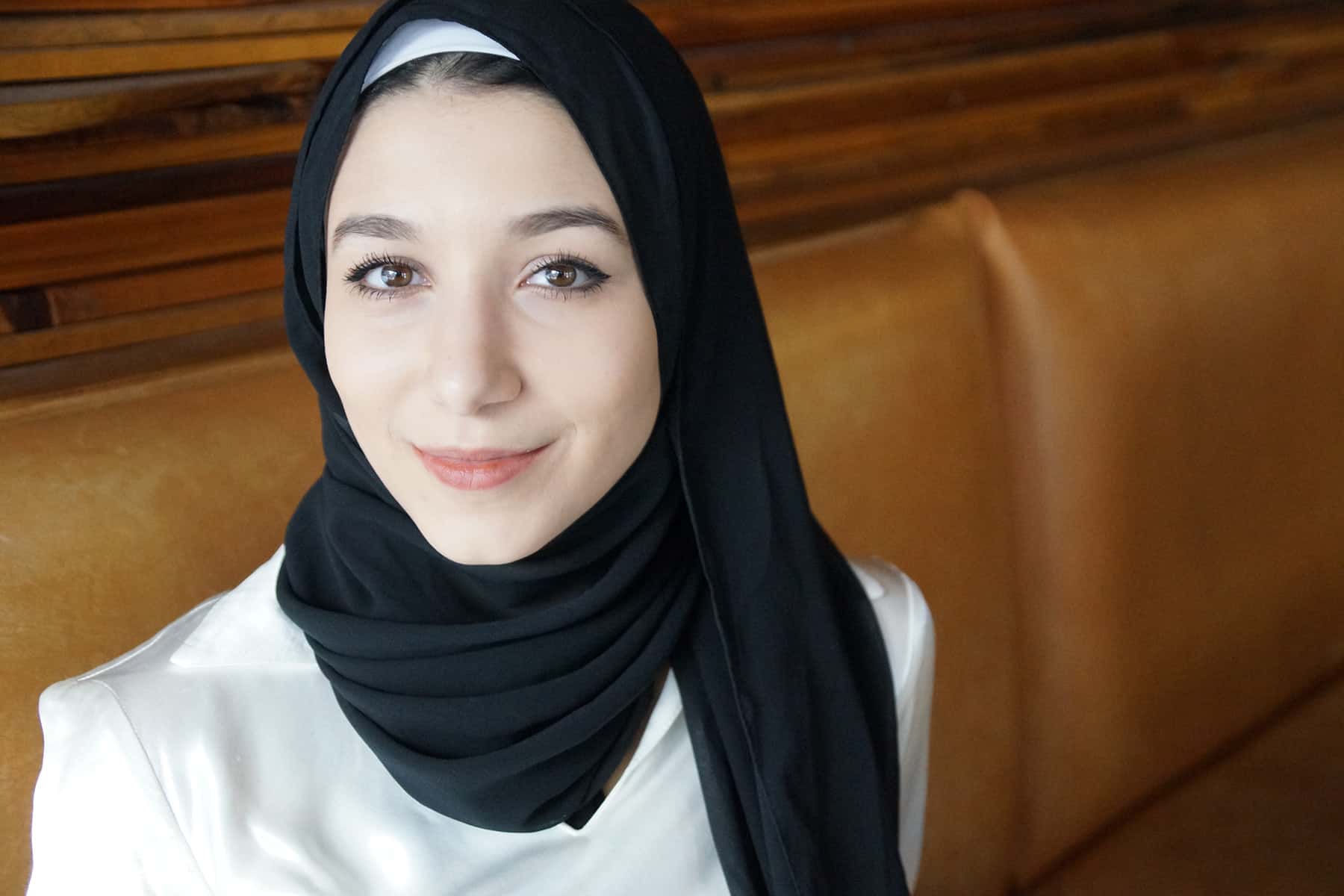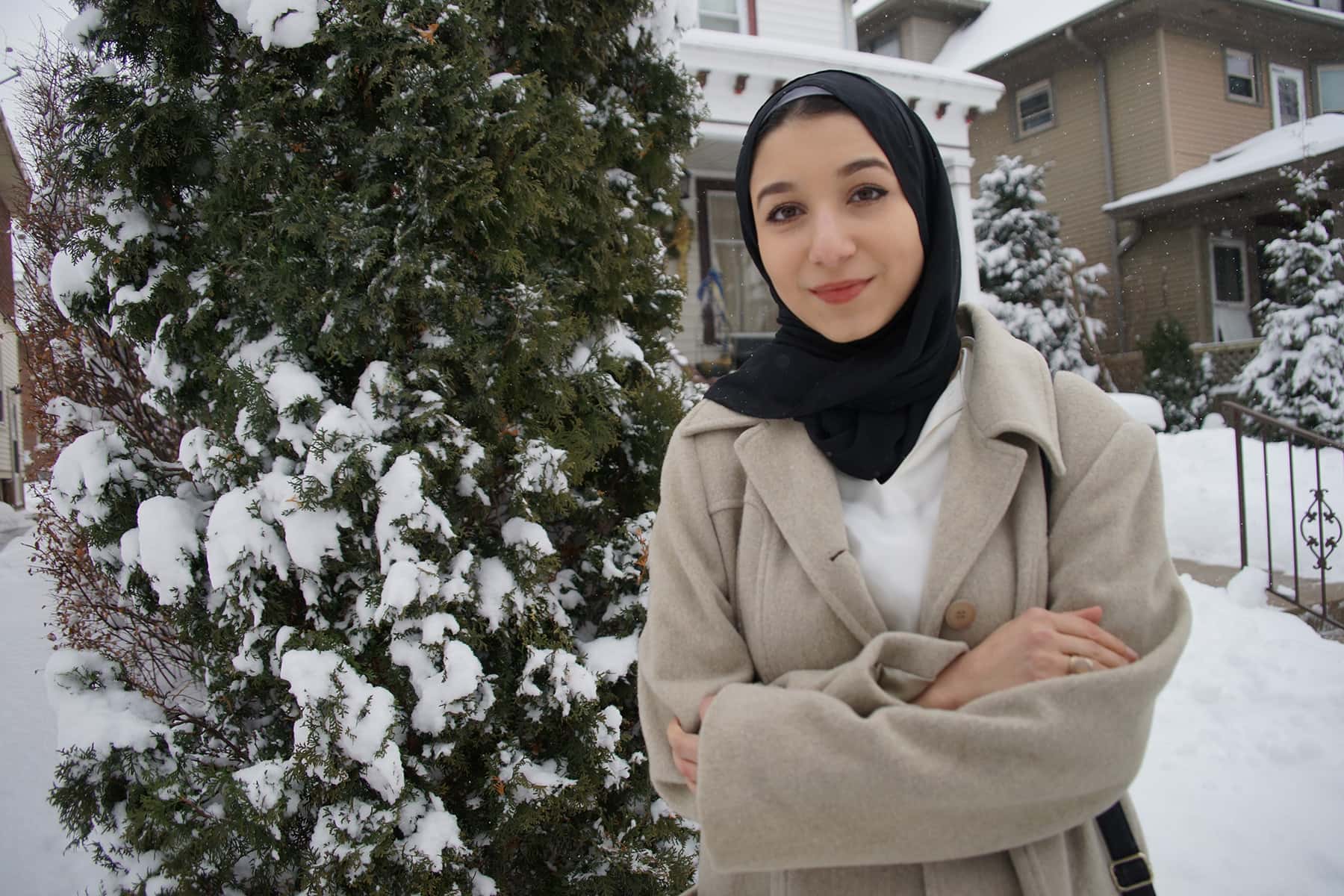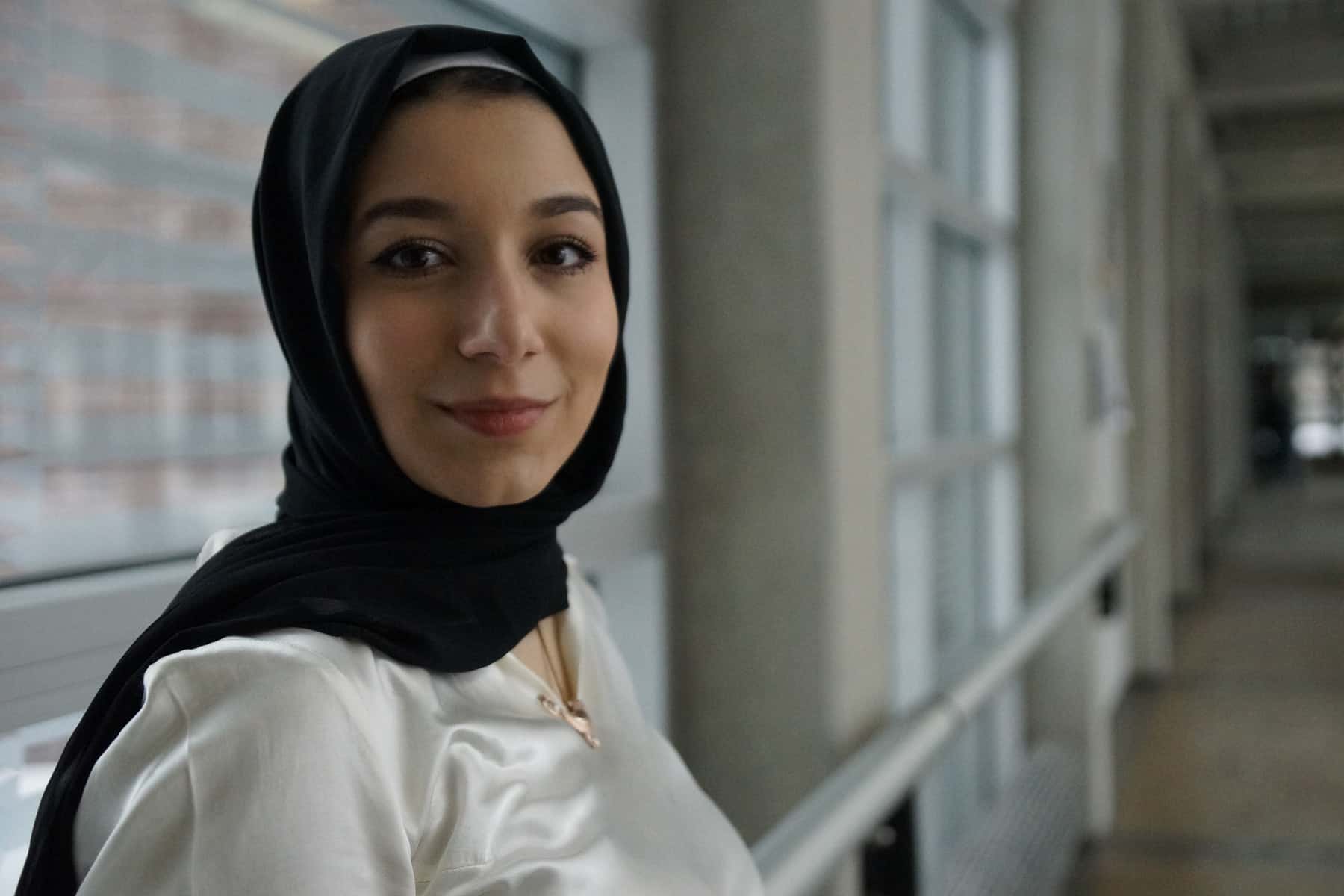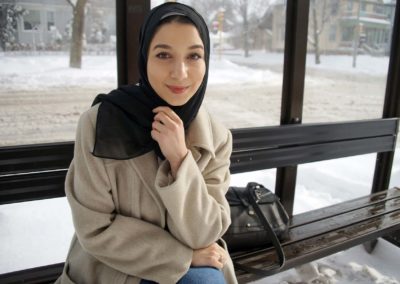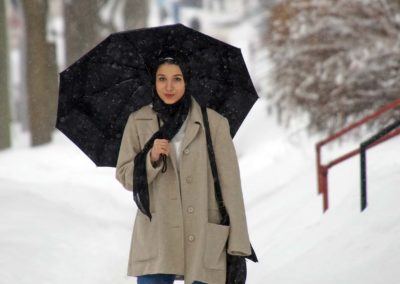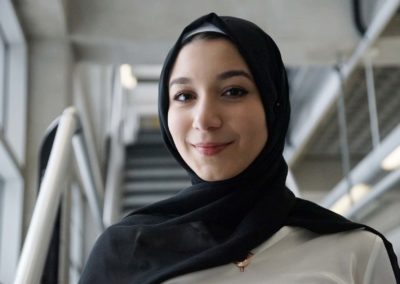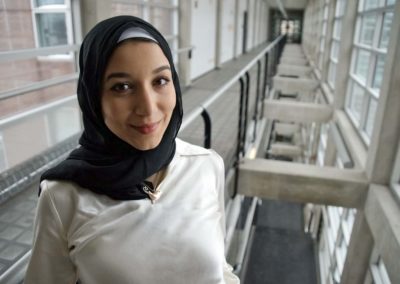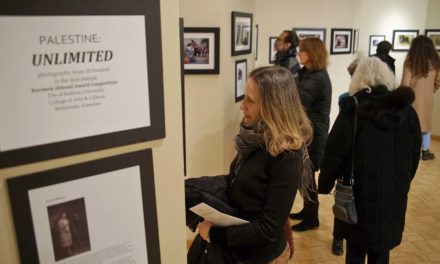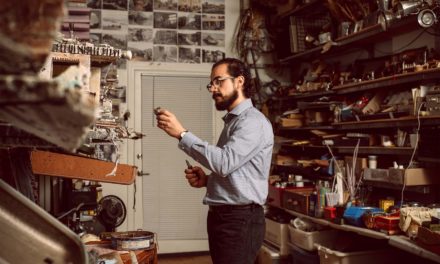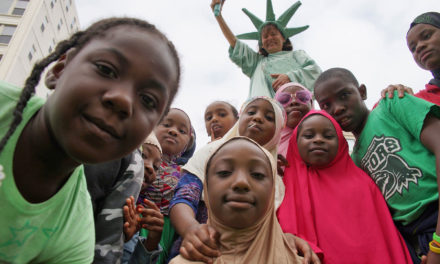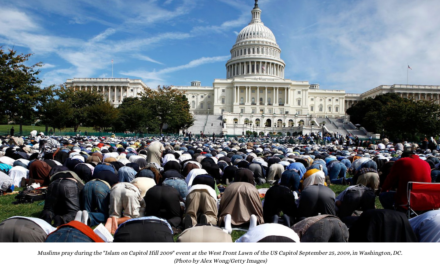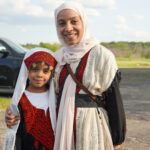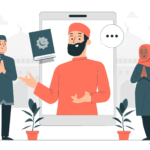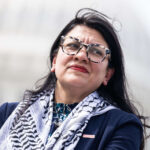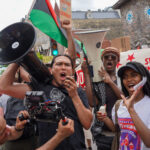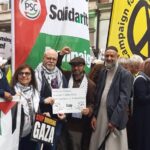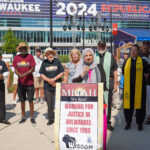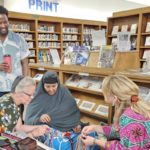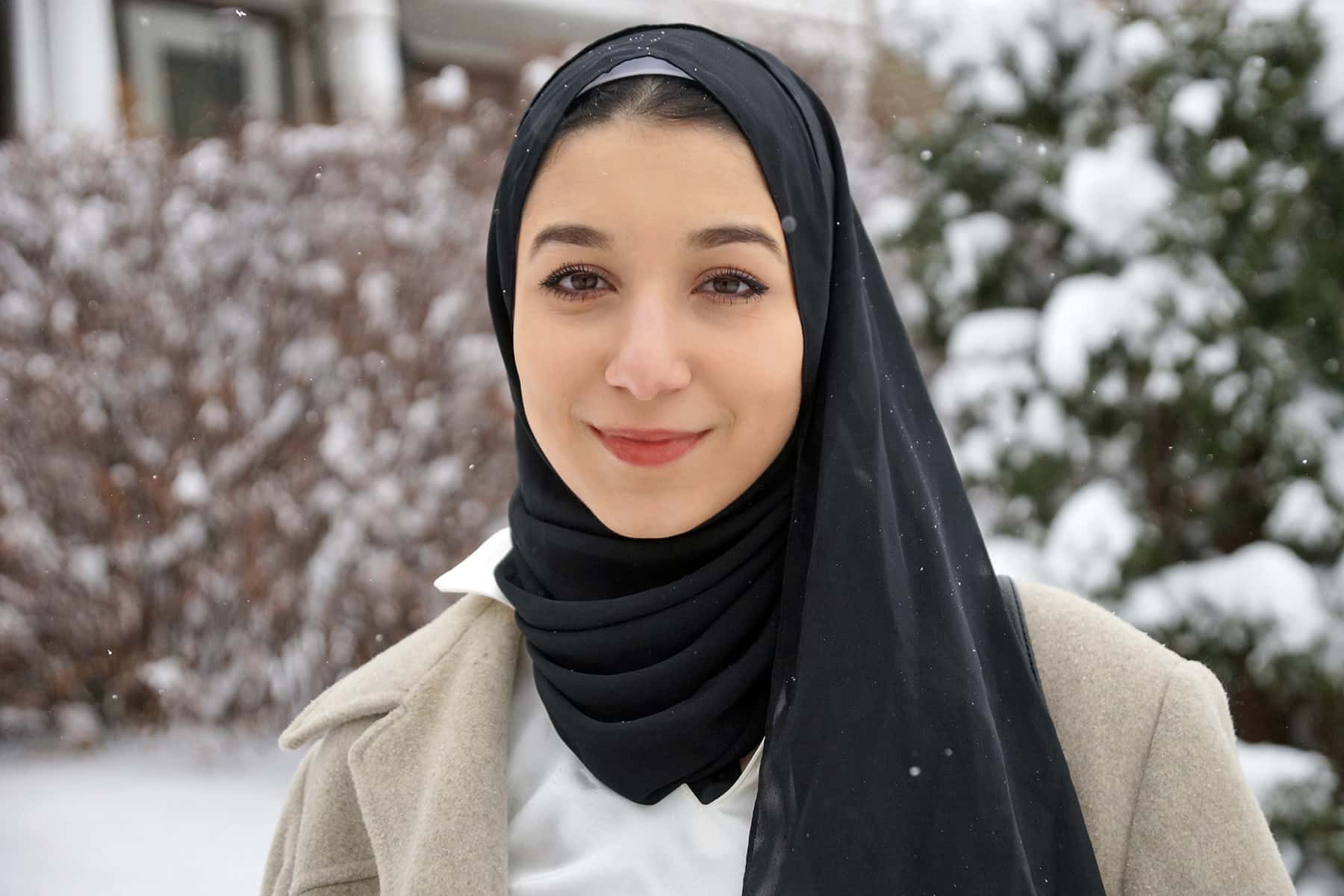
This interview is part of an ongoing editorial series. Each segment highlights a woman in the Wisconsin community. The stories are intended to share personal struggles, public achievements, and the social complexities with their Muslim identity.
As a young Palestinian artist and graduate from the University of Wisconsin-Milwaukee School of Architecture & Urban Planning, Aya Mustafa was attracted to design at just eight years old.
Her recent design project for the Museum of the Palestinian People in Washington DC is one of the many pieces that showcase her heritage and community through creative expression. Mustafa explores the misunderstandings people have about artists, and discusses how faith plays a role in her identity and art. She also bravely discusses her struggles with depression and PTSD, and the tension it has on her self-image and creativity.
Q&A with Aya Mustafa
Wisconsin Muslim Journal: How did being creative influence your youth?
Aya Mustafa: This question requires much thought and reflection. They say the world through a child’s eyes is so vibrant, pure and joyous. Children are creative thinkers, growing up imagining various worlds and scenarios. An Oaktree becomes a castle, a pond becomes a sea of chocolate, a rock becomes a dragon’s egg. Now imagine your world when you keep those eyes you possessed as a child. Everything is still as colorful and unique, reality never really seems to set in. That is the life of a creative individual; mine takes a unique turn.
When I was younger, it made everything so much more fun. It helped me get past the insecurities I grew up with. I had a hobby of drawing and painting, it began from just pure escapism and imagination as a kid. I was in my own world, where no one can hurt me, and I was free to do and think as I wanted. It helped me be a more confident student, a better friend, and a more caring human being. In school, I had the most fun creating visuals for the books I read. My high school English literature teacher still has my paintings on the classroom wall; a vampire for ‘Dracula,’ by Bram Stoker, a painting of ‘The Old Man and the Sea’ by Earnest Hemingway, and many more. Another memory was an art auction I was a part of, to help raise money for Palestinian and Syrian refugees in the war. I believe this was one of the rare moments in my childhood where I felt like, with discipline and consistency, my talent could be used for so much good. It wasn’t useless or ‘just for fun.’ I felt closer to myself, and my Palestinian and Muslim community more than ever.
My creativity has helped me in many other ways. When I needed to buy my friends gifts, I would make them gifts. I thrifted and created interesting outfits when nothing at the mall inspired me. Many complement my clothing, to my surprise, and even started thrifting themselves. It honestly brought things home that there are so many creative solutions to many problems we have in our everyday life.
Creativity makes my life astronomically more fulfilling, interesting, and blissful. I grew up with it in a unique way, fighting to not lose my creative drive to anything or anyone. I am twenty-two right now, and still fighting as I am transitioning from youth to adult. I must say that being a creatively intelligent individual is something I am most grateful for, because truthfully I do not feel like I would be as resilient as I am, if it weren’t for it. It has made me feel safe in my solitude and content regardless of any tragedy, heartbreak or loneliness that may come my way. My house can be burnt down, my degree could be taken away, but my inventiveness, visions, originality, is something that cannot be taken away. It is freeing in a world where licenses, degrees, material possessions and income are considered to make up the value of an individual.
My creativity influenced my learning. I create worlds from the texts I read. The shows I watch. The people I meet. The songs I listen to. The words I write. I am a pure escapist and live in my mind. I turn reality into ideal situations; sometimes I am unsure if it’s healthy the older I become, but I am stubborn to reality, and challenge it in every way possible. Creativity has allowed me to embrace the tension that life brings. Most of all, it has allowed me to turn my pain into something beautiful. That is where the unique turn comes in. I am not a happy and joyous person, but that doesn’t dim the embers of my creative heart as most assume, I am happy in my own way. I see happiness through a different light, I think beyond the traditional, solve problems in new ways, and take risks regardless of fear and self-doubt. Creativity is more than skill to draw or make things, the root word is ‘to grow’ and that is what I am always doing, God willing.
Wisconsin Muslim Journal: What is your family background and how did that support your aspirations?
Aya Mustafa: Both my parents are from Palestine. My dad is from a small village, Jilijliyeh, North of the Ramallah and al-Bireh Governorate in northern West bank. My mother is from a village called al-Libban. Although my parents were born in Palestine, they moved quite a bit to find a good life. My mother’s family lived in Kuwait for a short time, and then moved to Amman, Jordan after my grandpa (mom) passed away. My father’s family also lived in Kuwait. My grandpa (dad) passed away when my father was only six years’ old, so they moved there.
My father immigrated to the states when he was only nineteen years old. He worked hard for a new start, something I will never be able to truly pay him back for. For eight years he lived in Milwaukee, working every job he could, learning a new language, gaining an education. He then married my mom in Jordan, and they moved back to Milwaukee together to then have their six kids.
Wisconsin Muslim Journal: What got you interested in design, and has it taught you about yourself?
Aya Mustafa: My mother. It was such a simple gesture, yet has influenced me greatly. I was eight years old. It was when my mom was helping me with my Arabic homework; she was teaching me how to write the Arabic word for ‘Bird.’ For fun she simply drew one, and I still remember how excited I was. At that very moment, my mom was superhuman, she brought it to life. It was this simple guide from my mother that allowed me to find it in myself to be more inventive, imaginative, and original growing up. I would not be the person I am today without that gentle and beautiful free spirit that is my mother. I recently bought a pendant of a bird, that I always wear to symbolize this memory, and remind myself where I started and why I need to keep going. My mom will argue that I overdramatized this memory, but hey the world through a child’s eyes right?
It always intrigued me how much we benefit from art and design. Ideas constantly race through my mind, not just in architecture but for so many other things that may seem irrelevant to my major. The opportunities to apply design can be overwhelming, but it’s also humbling and exciting. Design has taught me, that I embody more strength and resilience than I thought I had. It taught me that I have so much to offer the world even when I feel otherwise. It taught me that sometimes I look too deeply into the simplest of things, but that is not a negative thing. It taught me how to bring color into others’ worlds when my own is black and white, and to not be a surface-level individual.
Wisconsin Muslim Journal: What role does your faith have with your personal identity? And what impact does it have on your art?
Aya Mustafa: Truthfully, I could answer this question in numerous ways, and still feel unsatisfied with my answer.
My Islamic faith transforms my personal characteristics; they are not only mine, but reflect much on my religion as well. That in itself is both challenging and humbling. For good reason. Faith is everything; I am Muslim externally as well as internally. The reality being, I would not have the skills I have, or my creative mind if it were not for God choosing to bless me with them. That is why I believe I cannot boast about myself, accomplishments, characteristics or uniqueness. Because once we become truly faithful, everything about me becomes something to benefit my faith and its message. But I do not believe that I need only include religious connotations to prove my Muslim Identity in the art and design world. It is much more than that.
My religion detoxifies my mind, and helps me break down what is truly important and what is a distraction. It helps me care more about what God accepts rather than society’s ideals. Being a Muslim artist is more than wearing a veil to fit the exterior mold, it is more than coming from an Arabic background, and it is more than drawing stereotypical designs that fit the theme of “Islam” and “Muslim.” Being a Muslim Artist means living by Islamic principles, defending what is right, going against what is wrong, giving voice to the voiceless. This question is actually one I have been asking myself my entire life because I am still figuring myself out. I do know that Allah did not just bless me with these skills to keep them for myself, and InshAllah one day, it will be more clear.
Wisconsin Muslim Journal: Are there aspects of your Palestinian heritage that direct you as a creative person?
Aya Mustafa: As a Palestinian American and aspiring architect, I believe in the power of change and healing that architecture, art, and design has on communities. In our world today, politics and miscommunication play a large role in the disconnect, ignorance, and division in many communities. I aspire to give back to my community, and my Palestinian heritage is one that inspires me and gives me strength every day to make this dream a reality.
Here is a little excerpt from my recent design project of the Museum of Palestinian People in Washington D.C. as a prime example of how my Palestinian heritage really inspired and motivated me creatively. As well as obligated me to give back to my Palestinian community:
“By helping with the design, message, and renovation of the Museum, it will educate my fellow Americans about my people and unify us instead of being divided by fearing the unknown. It will also help my dear Palestinians, with the creation of a space that heals and reminds them of their people, and our many stories. I believe this project will help me grow as a designer, because it is about real life, and it helps me let go of the depression that I experienced for so long. That condition came from not knowing who I was, feeling disconnected from myself, lost, not feeling Palestinian enough, Arab enough, American enough. This is a museum for the Palestinian people, by the Palestinian people. That is why I am very passionate about it, because I know I am not alone.
Through design, and good intentions I hope to give back to a community of Palestinians that feel homesick every day and provide them a new appreciation for their homeland in a space that values them and highlights them as more than an Occupation, but for the amazing people they are. Architecture has that power to bring knowledge, ideas, and unity back to where it was once lost. I have always believed in the deeper relationships we need to have between architecture and ourselves. This project is far beyond the blueprint of designing; it aims to produce communities as well as a museum. This museum project is more than an expression of the trauma from war. It makes our aspirations for a peaceful future visible.”
Wisconsin Muslim Journal: What do you feel is the biggest misunderstanding people have about being artistic?
Aya Mustafa: To be creative is to be different, and those who are different are so often misunderstood. It is as simple as that. So to choose the “biggest misunderstanding” is very difficult. I will try to point out misunderstandings I have faced from personal experience, that I am sure many other creative artists have faced as well.
Creativity is not that imperative or significant, and is worth neglecting.
Coming from such a rich culture, traditionally, some view a woman’s skill set as those that she will use primarily after marriage (taking care of her family), I didn’t believe my skills were useful at all, let alone to be supported or talked about such as this. It always seemed useless, because I had imagined that I would eventually get married and never have time to paint or draw. Some see certain art as a waste of time, and even as being unproductive.
Also, even when we get beyond these stereotypes, art is still not deemed as important as science and medicine. Many will joke how, since my parents immigrated from their countries to start a better life, taking the creative route is not working hard to repay them for their efforts and sacrifices. This is an attitude that suffocated me growing up, but motivates me in the present.
I believe that most people believe that creativity is easy, as if it were an epiphany, or inborn talent.
Simply, it is rarely that. Creativity is a process, way of life, and takes much labor and follow through. It is more than fun ideas and art supplies. If you think otherwise, it is most likely coming from an ignorant and influenced point of view. One that needs to change so we may all learn to respect one another’s paths in life.
Wisconsin Muslim Journal: In a segregated city like Milwaukee, do you experience challenges or judgments based on your gender, faith, or simply how you look?
Aya Mustafa: I grew up on the Southside of Milwaukee, and attended Salam School, a private Muslim school five minutes from my home. I had a strict curfew, only hung out with my Muslim friends from class or the Muslim community, and never really went anywhere outside of my family’s comfort zone. My parents worried; growing up during the aftermath of 9/11, it was not easy for them to trust and kept to themselves (although we were kind to our neighbors and any encounters with curious individuals asking us about our faith). So I cannot really say I faced much discrimination thankfully, other than macro-aggressions when shopping, eating out, etc. A young lady, at the mall, yelled at me to take off “that thing on my head,” and I remember feeling so surprised and confused.
Thinking back, I guess, that was something, since I still remember it clearly. Even as a child, you can’t help but feel so evidently how much of a foreigner you were, regardless of having been born and raised in the city. Alhamdulillah, (Thanks to God) I grew up with a great support system in school since my high school was primarily Brown Muslim students. I never had to face real discrimination in a public school, since I was no different in faith or culture than those around me. I was very sheltered, and transitioning out of my comfort zone was difficult but rewarding.
After graduating, I went to a technical college, also on the Southside of Milwaukee, before I transferred to study Architecture in UW-Milwaukee for my last 3.5 years of university. University is when I was really exposed to other minorities, as well as the majority of white people. It was also when it truly became clear that Milwaukee, the city I grew to love and call home, was indeed segregated and needed much work done to connect different communities. I did research and realized I lived in the most segregated city in the United States.
My School of Architecture was primarily white people. I was one of a few Arab students, there were two African Americans in the entire school, and not many minority professors teaching us. I remember my professor was doing a role-play exercise in class, and saw that I was wearing a bright blue hijab, and asked “honey, are you up to date on pop culture?” Many of the caucasian students I met in school, came from small towns outside of the city, and never encountered an Arab or even a Muslim before (due to no fault of their own). It was interesting and different, but sometimes frustrating not having an opportunity to make a real first impression on them, since they created one on their own from what they see in the media.
I hated feeling generalized, and distant from most because of the perceived differences in cultures and beliefs. In architecture school, you gain friendships closer than any other school because of how long we stay in our studios, we spend long and difficult hours trying to make something of ourselves in a major that is very challenging. It was difficult because anything you do will be automatically connected to the majority of Muslims, so it added pressure on me to do well, and act well so I will not be used to negatively represent all Muslims. I cannot complain though, UW-Milwaukee is really diverse and is a great institution in the city that brings different communities together.
Wisconsin Muslim Journal: What was the biggest challenge you faced to fulfill your creativity? And, what encouragement would you offer to Muslim youth about pursuing a career in the creative field?
Aya Mustafa: God (SWT) tests those He loves. I try to remind myself that every day, because I have faced my fair share of hardships. I was diagnosed with depression and PTSD, the winter of 2017. I grew up feeling very different, distant, and turned to my creativity to mask this mortifying feeling of not wanting to live anymore. I couldn’t shake this disinterest in life that it had given me. Being diagnosed was a confirmation. Confirmation that I was not like everyone around me, and didn’t have much control over my emotions.
The biggest tension it caused was with my faith, I felt like I lacked the Tawakkul (reliance) I needed to be a great Muslim. Getting treatment was the most challenging part, because it had gotten to a point where I lost interest in my artwork and lost faith in myself to make it in the creative world. Creativity takes so much hard work, resilience, and consistency. My depression destroyed my hope, blocked any creative ideas, and left me with no energy to hold a pen to paper.
Wisconsin Muslim Journal: What are your hopes for the future? What is the biggest dream you are trying to reach?
Aya Mustafa: On a Macro level, I dream to be an architectural engineer and use the knowledge I gain, and the skills I master to help the people in Palestine, and hopefully expand to more of the Muslim countries struggling through war. In school, what really pulled me towards architecture more and more is how it was one of the greatest healing factors after the World Wars. How it rebuilt societies, after years of destruction and turmoil. Architecture can do that, I want to do that, God willing.
On a micro level, I simply hope to truly become a better and healthier version of myself in the future. I strive to be at a point in my life where I am taking care of my creative self better and also giving back to my community. I want to be more than this façade I created for myself. I also hope to be someone younger artists can look up to and turn to when they too are questioning their creative paths and identities. Sometimes it is great to simplify short term aspirations, to better nurture the long term ones.
